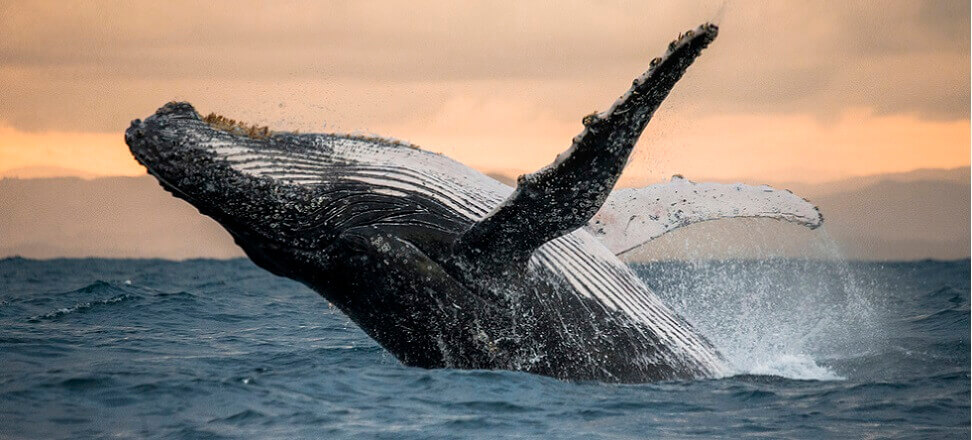Feedback, Issue 6/2024
The heaviest of whales
Record sizes in the animal world have always caused a sensation, as have their extreme abilities. The media are eager to grab viewers’ attention with headlines like: smallest, biggest, fastest, most venomous….
Records in the animal world
Formally, the largest known organism is the one discovered in 1998. In the Blue Mountains in Oregon, the mycelium of the dark mycelium(Armillaria ostoyae) [1], which overgrows an area of about 10 km2. The age of this organism is estimated at 2400 to 8650 years [2]. The blue whale(Balaenoptera musculus), which now grows up to 29.9 m in length and 199 t in weight, was considered the largest animal living in any period of history. He was the front-runner until last August, when a team of paleontologists, led by Giovanni Biannucci, published estimates in Nature for Perucetus colossus, which lived in the Eocene (56-33.9 million years ago) and belongs to the extinct basilosaurid family (Basilosauridae) – the most genetically advanced prawn, the first to lead a completely aquatic lifestyle.
On the origin of whales
The origin of whales has been a mystery to the scientific world for centuries. It was only at the beginning of the 21st century. it has been established beyond any doubt that cetaceans (Cetacea) evolved at the end of the early Eocene from cloven-hoofed quadrupeds (Artiodactyla) [3], feeding on aquatic vegetation in the coastal zone of lakes, streams and rivers of the Indian subcontinent – a splinter of Gondwana, which at the time was an island, sailing across the Tethys ocean to meet Asia. This is one of the warmest periods in Earth’s history. Thanks to the greenhouse effect [4], even greenhouse conditions prevailed at the time. In addition, the water level in the ocean reached up to 25 meters higher – the Sahara desert today was then the bottom of the Tethys ocean, and fossils of palm trees from this period are found today outside the Arctic Circle [5].
Leading an terrestrial lifestyle at the beginning of the middle Eocene, the righthanders quickly spread throughout the coastal zones of North and West Africa and the Americas. They then took the next step and switched to a fully aquatic mode, roaming all of Earth’s oceans in the late Eocene and occupying ecological niches abandoned by marine reptiles that became extinct after the Chicxulub meteor impact. They then gained a range of occurrence similar to that attributed to today’s whales.
This evolution took the cetaceans as long as 12 million years – four times longer than it took the ichthyosaurs to master the same ecological niches vacated after the great Cambrian extinction. Most of the prawaleni (Archaeoceti) subsequently fell victim to Eocene-Oligocene extinctions [6], most likely caused by climate cooling due to changes in ocean currents [7]. The decline in temperatures put an end to the greenhouse era of the early Cenozoic [8] and continues to this day, with the result, for example, of the glaciation of Antarctica. The Eocene world was finally sealed by the fall of several asteroids [9].
Toothfish, whalebone and… basilosaurs
The extinction was survived by two cetacean clades still alive today: the toothfish (Odontoceti), like modern orcas and dolphins, and the whalefish (Mysticeti), which include today’s whales. Cetaceans and mermaids (manatees and dugongs) remain the only groups of mammals that have a fully aquatic lifestyle, meaning they are born, sleep and reproduce in water, unlike seals, walruses and sea lions. Today’s cetaceans bear little resemblance to their Eocene ancestors, which were mostly large, swimming monsters armed with deadly dentition in an elongated jaw.
Early righthanders, such as the ambulocet, were more like crocodiles in body structure than today’s dolphins. Not surprisingly, when Richard Harlan came across the fossil of the first basilosaurus he thought he was dealing with a giant swimming reptile. And that’s where the name with the reptile ending saurus comes from [10].
Perucetus colossus – Earth’s heaviest animal?
Perucetus colossus , discovered in the Paracas region of Peru, is known from 4 ribs, 13 vertebrae and fragments of fin bone. All the remnants belonged to a single individual who did not live to see an even more pleasant name than MUSM 3248. Bianucci et alia, analyzing the fossils of the aforementioned basilosaurus, estimated that it was 17-20.1 m long and could have weighed as much as 340 t, significantly overshadowing the blue whale [11]. The structure of Perucetus was reconstructed based on comparisons with other basilosaurids that roamed the waters of the Tethys ocean, such as Cynthiacetus peruvianus [12], Basilosaurus isis [13], Pachycetus wardii [14] and Dorudon atrox [15]. They were large predators, often apex in their ecosystems, lacking the sense of echolocation associated with today’s toothfish, although they could probably hear directionally [16].
Calculating body mass in extinct mammals
Body mass in extinct mammals is sometimes estimated using three basic methods: 1) M1 tooth size measurement; 2) measuring the length of limb bones; 3) measuring the length of the body [17]. However, these methods cannot be applied directly to extinct cetaceans. Their cheek teeth have other functions (denticles) or have been lost (whalebone). Their limbs do not have to support their body weight. They have also undergone an evolutionary process of increasing the number of lumbar and caudal vertebrae relative to land mammals to better adapt to life in water. In addition to the aforementioned predictive methods of allometric equations, volumetric and hybrid methods were therefore introduced. For whales alive today, methods have also been developed to estimate body mass based on photogrammetry [18].
Perucetus ‘ bones are both denser and thicker than those of any other cetacean known to science (pachyosteosclerosis). They have twice the volume of comparable blue whale vertebrae! Their ribs are made only of dense bone, and have no marrow. The weight of the skeleton of a 20-meter-long Perucetus would therefore be two or three times that of a skeleton of a five-meter-long blue whale.
Bianucci’s team, in reconstructing this basilosaurus, therefore used modeling based on mermaids (diugos and manatees), which use their dense skeletons as ballast systems. This gave a weight of 85 to as much as 340 tons, with an average weight of 180 tons. Paleobiologists believe that Perucetus colossus was a fairly slow-moving inhabitant of the shallow water zone, whose great mass helped it maintain its stability despite strong swells and even storms. The findings have become a sensation.
And yet not…?
Two paleobiologists, Ryosuke Motani and Nicholas D. Pyenson, verified the Bianucci team’s calculations using their own bioinformatics tool [19] and published her thoughts in the Peer Journal in February 2024. They concluded that modeling Perucetus based on manatees is not valid, since whales are the only group of mammals in which such extreme gigantism has developed. They found that Perucetus, by 20 percent. shorter than a blue whale, it would have to be more than three times as dense or nearly twice as fat to be heavier than it.
This does not agree with the general parameters calculated for terrestrial vertebrates. Skeptical paleobiologists have relegated Perucetus to the 60-114 t weight category, with an assumed length of 17-20 m. It is necessary to add here that on average it would be about 60-70 t, similar to modern sperm whales. They pointed out that the ocean’s productivity would not maintain the homeostasis of a 340t animal. They added that the data collected on Perucetus is currently too scarce to accurately verify the estimates. Their calculations simultaneously suggest that the largest blue whale could be much heavier than previously thought, weighing up to 270 t. [20].
Will there be a Perucetus rematch?
Bianucci’s team is not laying down its arms, however, and promises to confirm the approach it is using. What about Perucetus? There is an ongoing debate about what such a powerful basilosaurus would eat. We do not have, unfortunately, any preserved skull of this righteousness. The theory that he was a vegetarian has been rejected. None of the righteous were, despite the plant-based diet of their ancestors… Bianucci and his team suggest that basilosaurus fed on mollusks, crustaceans and other creatures inhabiting the sea floor. It took them either by aspiration, like the beluga(Delphinapterus leucas), or by filtration, like the gray walrus(Eschrichtius robustus).
High body weight can help optimize metabolic and locomotor efficiency. In Earth’s oceans, such an arrangement has evolved several times, especially among toothless filter feeders that utilize dense clusters of fine food, like today’s whale sharks, manta rays and some sharks: whales(Rhincodon typus), longnose rays (Cetorhinus maximus) and largemouth bass(Megachasma pelagios). All of these filter feeders had smaller, sharp-toothed ancestors that hunted large, single prey. As an alternative, Bianucci and his team suggest that this largest of the prehistoric cetaceans may have been scavenging. The blue whale, meanwhile, continues to swim at the very top of the podium.
In the article, I used, among other things. From the works:
[1] Craig L. Schmitt and Michael L. Tatum (2008) The Malheur National Forest: Location of the World’s Largest Living Organism. Forest Service, United States Department of Agriculture
[2] Brennan A. Ferguson, Tina A. Dreisbach, C.G. Parks; Gregory M. Filip, C.L. Schmitt (2003) Coarse-scale population structure of pathogenic Armillaria species in a mixed-conifer forest in the Blue Mountains of northeast Oregon. “Canadian Journal of Forest Research” 33: 612-623
[3] In 1787, John Hunter, a famous surgeon and scientist of his era, noted the similarity between some of the anatomical arrangements of cetaceans and… ruminants. However, not having the theory of evolution in his arsenal, he did not dare to formulate the conclusions flowing from it. Almost a century later, William H. Flower (1883), relying on Hunter’s research, suggested the origin of whales from some early form of primitive ungulate mammal. He announced this in a lecture to the Royal Institution of Great Britain entitled On whales, past and present, and their probable origin. His hypothesis, however, did not receive a sympathetic reception at the time. It wasn’t until 1950 that Boyden and Gemeroy conducted a series of immune reactivity tests, comparing cetacean proteins with several modern mammalian orders. Their results confirmed Flower’s hypothesis, although other solutions continued to be pushed. In favor of the origin of cetaceans from cloven-hoofed mammals were the fossil discoveries of new species of pacicetids in the early 21st century by J. G. M. Thewissen, E. M. Williams, L. J., Roe, S. T. Hussain (2001) Skeletons of terrestrial cetaceans and the relationship of whales to artiodactyls. “Nature” 413(6853): 277-281. doi:10.1038/35095005, and finally the molecular studies of the even-toed Indohyus in 2007: Felix G. Marx, Olivier Lambert, Mark D. Uhen (2016) Cetacean Paleobiology, John Wiley & Sons Ltd.
[4] Carbon dioxide (CO2) levels in the Eocene reached 800-1000 ppm compared to current levels of 421.35 ppm and 385 ppm when Peter Ward wrote these words in: (2010) The Flooded Earth: Our Future in a World without Ice Caps. Basic Books.
[5] On the effect of the greenhouse effect in the Eocene, but also differences in, for example, the oxygenation level of the ocean at different depths: Peter Ward (2007) Under a Green Sky: Global Warming, Mass Extinctions of the Past, and What They Can Tell Us about Our Future. Harper-Collins.
[6] This event is known in Europe as the Grande Coupure – the great break, while in Asia it is called the Mongolian remodeling. In just one million years, half of the known mammalian genera became extinct: Simone Fattorini (2021) Eocene-Oligocene Mass Extinction in: Encyclopedia of Geology (second edition) vol. 5.
[7] Donald Prothero indicates that the peak of the extinction occurred as late as the middle Eocene, and that the cooling of the climate due to a change in the circulation of ocean currents was triggered by tectonic plate movements and the detachment of Australia from Antarctica: (2013) Bringing Fossils to Live: An Introduction to Paleobiology (third edition), Columbia University Press.
[8] As a result of the cooling of the climate at the beginning of the Oligocene, the ice caps at both poles were about 25% larger than they are today, while the water level in the Earth’s ocean was more than a hundred meters lower: Miriam E. Katz, Kenneth G. Miller, James D. Wright, Bridget S. Wade, James V. Browning, Benjamin S. Cramer, Yair Rosenthal (2008) Stepwise transition from the Eocene greenhouse to the Oligocene icehouse. “Nature Geoscience” 1:329-334 https://doi.org/10.1038/ngeo179
[9] As many as three impact craters, as well as evidence of increased volcanic activity, have been dated to an age of about 35 million years. The first, is the Chesapeake Bay crater in Virginia, USA. It has an inner diameter of 38 km and an outer diameter of about 85 km: J. W. Horton, J. Ormö, D. S. Powars, G. S. Gohn (2006) Chesapeake Bay impact structure: Morphology, crater fill, and relevance for impact structures on Mars. “Meteoritics & Planetary Science” 41(10):1613-1624. doi:10.1111/j.1945-5100.2006.tb00439.x. The other is the 100 km diameter Popigai crater in Siberia: Richard Bottomley, Richard Grieve, Derek York, Victor Masaitis (1997) The age of the Popigai impact event and its relation to events at the Eocene/Oligocene boundary. “Nature” 388:365-368. https://doi.org/10.1038/41073 The third is Toms Canyon in New Jersey, with a diameter of 22 km: Steven M. Stanley and John Luczaj (2015) Earth System History (fourth edition). W. H. Freeman and Company, New York. Geological studies have shown that the meteorites did not come from a single asteroid, although they may have hit Earth as a result of a single gravitational disturbance in the Asteroid Belt: Birger Schmitz, Samuele Boschi, Anders Cronholm, Philipp R. Heck, Simonetta Monechi, Alessandro Montanari, Fredrik Terfelt (2015) Fragments of Late Eocene Earth-impacting asteroids linked to disturbance of asteroid belt. “Earth and Planetary Science Letters” 425:77-83.
[10] Harlan’s mistake was straightened out a few years later by Sir Richard Owen, who compared basilosaurus teeth with various species of modern animals: Mark D. Uhen (1998) Middle to Late Eocene Basilosaurines and Dorudontines (in:) J. G. M. Thewissen (ed.) The Emergence of Whales: Evolutionary Patterns in the Origin of Cetacea. s. Advances in Vertebrate Paleobiology, vol 1. Springer. https://doi.org/10.1007/978-1-4899-0159-0_2
[11] Revelations regarding weight Perucetus published team: Giovanni Bianucci, Olivier Lambert, Mario Urbina, Marco Merella, Alberto Collareta, Rebecca Bennion, Rodolfo Salas-Gismondi, Aldo Benites-Palomino, Klaas Post, Christian de Muizon, Giulia Bosio, Claudio Di Celma, Elisa Malinverno, Pietro Paolo Pierantoni, Igor Maria Villa, Eli Amson (2023) A heavyweight early whale pushes the boundaries of vertebrate morphology. “Nature” 620: 824-829 https://doi.org/10.1038/s41586-023-06381-1
[12] A powerful carnivore with the most complete skeleton among all basulosaurids: Manuel Martínez-Cáceres; Olivier Lambert; Christian de Muizon (2017) The anatomy and phylogenetic affinities of Cynthiacetus peruvianus, a large Dorudon-like basilosaurid (Cetacea, Mammalia) from the late Eocene of Peru. “Geodiversitas 39(1):7-163. https://doi.org/10.5252/g2017n1a1
[13] Iyad S. Zalmout, Hakam A. Mustafa, Philip D. Gingerich (2000) Priabonian Basilosaurus isis (Cetacea) from the Wadi Esh-Shallala Formation: first marine mammal from the Eocene of Jordan. “Journal of Vertebrate Paleontology” 20:201-204.
[14] Creatures of the genera Pachycetus and Anthaceuts had much denser bones than other basilosaurids: Philip D. Gingerich, Ayoub Amane, Samir Zouhri (2022) Skull and partial skeleton of a new pachycetine genus (Cetacea, Basilosauridae) from the Aridal Formation, Bartonian middle Eocene, of southwestern Morocco. “PLoS One” doi: 10.1371/journal.pone.0276110
[15] The subfamily Dorudontinae is considered the most likely ancestor of present-day cetaceans, sharing many features with them, while lacking some of the features that separate modern cetaceans from ancient basalosaurs: Mark D. Uhen (2004) Form, Function, and Anatomy of Dorudon atrox (Mammalia, Cetacea): An Archaeocete from the Middle to Late Eocene of Egypt. “Papers on Paleontology,” 34, Museum of Paleontology, The University of Michigan.
[16] Due to the faster speed of sound propagation in water, humans are unable to tell the direction of origin of the sound, which seems to arrive from all sides – a phenomenon familiar to divers. To nullify the effect, simply increase the distance between the sound measuring points, for example, by inserting plastic drink straws found underwater into one’s ears.
[17] Legendre correlated the natural logarithm of the M1 tooth area with the body mass of many groups of modern mammals: (1986) Analysis of mammalian communities from the late Eocene and Oligocene of southern France. “Paleovertebrata,” Montpellier, 16(4):191-212. Gingerich found relationships between limb length and body size: (1990) Prediction of body mass in mammalian species from long bone lengths and diameters. “Contributions from the Museum of Paleontology, University of Michigan” 28(4):79-92. Jerison used the body length of modern carnivores and ruminants to estimate their mass: (1973) Evolution of the Brain and Intelligence. Academic Press, New York. The comparisons are based on a subjectively selected group of modern animals, giving considerable uncertainty in the results. For example, body mass estimates of a giant sloth Megatherium americanum range from 0.5 to 97 tons, using the same algorithms and calibration data set, depending on whether one chooses the diameter of its transverse radius bone and or femur: Charlotte A. Brassey (2016) Body-Mass Estimation in Paleontology: A Review of Volumetric Techniques.. “The Paleontological Society Papers” 22:133-156. doi:10.1017/scs.2017.12
[18] A floating giant would be hard to weigh: Fredrik Christiansen, Mariano Sironi, Michael J. Moore, Matías Di Martino, Marcos Ricciardi, Hunter A. Warick, Duncan J. Irschick, Robert Gutierrez, Marcela M. Uhart (2019) Estimating body mass of free-living whales using aerial photogrammetry and 3D volumetrics. “Methods in Ecology and Evolution” 10: 2034-2044. https://doi.org/10.1111/2041-210X.13298
[19] Paleomass is a tool for estimating the body mass of marine vertebrates based on their orthogonal silhouettes using an encirclement algorithm. It generates a set of two 3D models, assuming superelliptical cross sections of the body with different exponent values. The software makes it possible to determine the volume of an animal between the volumes of the two models by selecting parameters accordingly: Ryosuke Motani (2023) Paleomass for R-bracketing body volume of marine vertebrates with 3D models. “Peer Journal” 11:e15957. https://doi.org/10.7717/peerj.15957
[20] Ryosuke Motani, Nicholas D. Pyenson (2024) Downsizing a heavyweight: factors and methods that revise weight estimates of the giant fossil whale Perucetus colossus. “Peer Journal” 12:e16978 https://doi.org/10.7717/peerj.16978

 Polski
Polski







